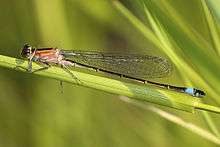Blue-tailed damselfly
| Blue-tailed damselfly | |
|---|---|
_male_adult.jpg) | |
| Mature male | |
 | |
| Female, form rufescens | |
| Scientific classification | |
| Kingdom: | Animalia |
| Phylum: | Arthropoda |
| Class: | Insecta |
| Order: | Odonata |
| Suborder: | Zygoptera |
| Family: | Coenagrionidae |
| Genus: | Ischnura |
| Species: | I. elegans |
| Binomial name | |
| Ischnura elegans (Vander Linden, 1820) | |
The blue-tailed damselfly (Ischnura elegans) is a European damselfly.
Males
Adult male blue-tailed damselflies have a head and thorax patterned with blue and black. They have a largely black abdomen with very narrow pale markings where each segment joins the next. Segment eight, however, is entirely pale blue. At rest, the wings of most damselfly species are held back together, unlike dragonflies, which rest with their wings out flat. The thorax of juvenile males has a green tinge. A male can try to interfere with a mating pair, by attaching itself to the mating male.
-
_immature_male.jpg)
Immature male
-
_two_males_and_female_(typica).jpg)
Two males and a female form typica
Female forms
Female blue-tailed Damselflies come in a variety of colour forms. Juveniles may be salmon pink, form rufescens; violet, form violacea and a pale green form. The colour darkens as the damselfly ages. Mature females may be blue like the male, form typica; olive green thorax and brown spot, form infuscans or pale brown thorax and brown spot, form infusca-obseleta.
-
_mating%2C_female_typica_2.jpg)
Male mating with female form typica
-
_female_violacea.jpg)
Female form violacea
-
_female_rufescens.jpg)
Female form rufescens
-
.jpg)
Female form infuscans
-
_female_infuscans-obsoleta_2.jpg)
Female form infuscans-obsoleta
-
_female_rufescens-obsoleta.jpg)
Female form rufescens-obsoleta
-
_female_rufescens-obsoleta_2.jpg)
Female form rufescens-obsoleta (mature)
Damselfly nymphs are aquatic, and prey on small aquatic insects or other aquatic larvae. The adult damselflies prey on small flying insects, caught using their legs like a basket to scoop the prey up while flying, or insects taken from leaves.
-
Mating wheel
-
_mating_female_typica_3.jpg)
Mating, female form typica
-
_mating_female_infuscans-obsoleta.jpg)
Mating, female form infuscans-obsoleta
-
_mating_female_violacea.jpg)
Mating, female form violacea
-
_nymph.jpg)
nymph
-

emerging
References
- "Ischnura elegans". British Dragonfly Society. Retrieved 10 Jun 2014.
- Watson, L. & Dallwitz, M.J. (2003 onwards). "Ischnura elegans". British insects: the Odonata (dragonflies and damselflies). Retrieved 15 October 2010. Check date values in:
|date=(help)
| Wikimedia Commons has media related to Ischnura elegans. |
| Wikispecies has information related to: Ischnura elegans |
